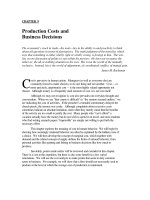mms technologies usage and business models
Bạn đang xem bản rút gọn của tài liệu. Xem và tải ngay bản đầy đủ của tài liệu tại đây (5.12 MB, 385 trang )
MMS
Technologies, Usage and Business Models
Daniel Ralph
BTexact Technologies, Ipswich, UK
Paul Graham
eServGlobal, Ipswich, UK
MMS
Technologies, Usage and Business Models
MMS
Technologies, Usage and Business Models
Daniel Ralph
BTexact Technologies, Ipswich, UK
Paul Graham
eServGlobal, Ipswich, UK
Copyright # 2004 John Wiley & Sons Ltd, The Atrium, Southern Gate, Chichester,
West Sussex PO19 8SQ, England
Telephone (þ44) 1243 779777
Email (for orders and customer service enquiries):
Visit our Home Page on www.wileyeurope.com or www.wiley.com
All Rights Reserved. No part of this publication may be reproduced, stored in a retrieval
system or transmitted in any form or by any means, electronic, mechanical, photocopying,
recording, scanning or otherwise, except under the terms of the Copyright, Designs and
Patents Act 1988 or under the terms of a licence issued by the Copyright Licensing Agency
Ltd, 90 Tottenham Court Road, London W1T 4LP, UK, without the permission in writing of
the Publisher. Requests to the Publisher should be addressed to the Permissions Department,
John Wiley & Sons Ltd, The Atrium, Southern Gate, Chichester, West Sussex PO19 8SQ,
England, or emailed to , or faxed to (þ44) 1243 770620
This publication is designed to provide accurate and authoritative information in regard to
the subject matter covered. It is sold on the understanding that the Publisher is not engaged
in rendering professional services. If professional advice or other expert assistance is
required, the services of a competent professional should be sought.
Other Wiley Editorial Offices
John Wiley & Sons Inc., 111 River Street, Hoboken, NJ 07030, USA
Jossey-Bass, 989 Market Street, San Francisco, CA 94103-1741, USA
Wiley-VCH Verlag GmbH, Boschstr. 12, D-69469 Weinheim, Germany
John Wiley & Sons Australia Ltd, 33 Park Road, Milton, Queensland 4064, Australia
John Wiley & Sons (Asia) Pte Ltd, 2 Clementi Loop #02-01, Jin Xing Distripark, Singapore 129809
John Wiley & Sons Canada Ltd, 22 Worcester Road, Etobicoke, Ontario, Canada M9W 1L1
Wiley also publishes its books in a variety of electronic formats. Some content that appears in print
may not be available in electronic books.
British Library Cataloguing in Publication Data
A catalogue record for this book is available from the British Library
ISBN 0-470-86116-9
Project management by Originator, Gt Yarmouth, Norfolk (typeset in 11/13pt Palatino)
Printed and bound in Great Britain by Antony Rowe, Chippenham, Wiltshire
This book is printed on acid-free paper responsibly manufactured from sustainable forestry
in which at least two trees are planted for each one used for paper production.
Contents
About the Authors xiii
How This Book Is Organized xv
Acknowledgements xxi
Part I Mobile Messaging Business Challenges 1
1 Multimedia Messaging Overview 3
1.1 Introduction 3
1.2 What is multimedia messaging? 4
1.2.1 Vodafone Live! service 7
1.2.2 Services on offer 10
1.2.3 J-Phone Sha-Mail service 12
1.2.4 Openwave Multimedia Messaging Service Centre 14
1.2.5 MMSC for carriers 15
1.2.6 MMSC for end-users 16
1.3 Growing mobile data revenues 16
1.3.1 Device availability 16
1.3.2 Convergence 18
1.3.3 Toward third generation 20
1.3.4 Support technologies 22
1.3.4.1 Location information 23
1.3.4.2 Personalization 25
1.3.4.3 Mobile commerce 28
1.3.4.4 Unstructured Supplementary Service Data 29
1.4 The challenges of multimedia messaging 30
1.4.1 Usability 30
1.4.2 New usage scenarios 32
1.4.3 New business models 33
Multimedia Messaging Service Daniel Ralph and Paul Graham
# 2004 John Wiley & Sons, Ltd ISBN: 0-470-86116-9
1.4.4 The interoperability challenge 37
1.4.5 Security and privacy 38
2 The Multimedia Messaging Value Chain 39
2.1 Introduction 39
2.2 Infrastructure equipment vendors 40
2.3 Content providers 41
2.4 Mobile device manufacturers 43
2.5 Mobile network operators 45
2.5.1 Revenue share business models 52
2.5.2 Sponsorship business models 54
2.5.3 Subscription business models 56
2.5.4 Digital Rights Management (DRM) 56
2.6 Concluding remarks 60
Part II The Technologies of Multimedia Messaging 61
3 A Standards-based Approach 63
3.1 Introduction 63
3.2 Overview of MMS specifications 64
3.2.1 To receive a message 65
3.2.2 To send a message 66
3.3 3GPP Release 5 – architecture overview 68
3.4 What is an MMSC? 68
3.5 Basic functionality of an MMSC 70
3.6 MMS addressing models 71
3.6.1 Multimedia Messaging Service Environment 72
3.6.1.1 MMSNA 72
3.6.1.2 MMS relay/server 73
3.6.1.3 MMS user databases 74
3.6.1.4 MMS user agent 74
3.6.1.5 MMS VAS applications 75
3.6.1.6 MMS reference architecture 75
3.7 MM4: Interworking of different MMSEs 76
3.8 MM7: MMS relay/server – MMS VAS applications 76
3.9 Example of MMS interaction with 2G/3G voicemailboxes 78
3.10 Open Mobile Alliance – the WAP standard 79
3.10.1 Architectural support for MMS 80
3.11 MMS and WAP-PUSH 81
3.12 Future developments 83
3.12.1 MMS user agent (MM1) 83
3.12.2 Interworking with legacy systems (MM3) 83
3.12.3 Interconnection with different MMSEs (MM4) 83
3.12.4 User database-related items (MM6) 83
3.12.5 Value Added Service Provider-related items (MM7) 84
3.12.6 Billing-related items (MM8) 84
3.12.7 End-to-end service items 84
vi CONTENTS
4 Application Layer 87
4.1 Introduction 87
4.2 What is scalable vector graphics? 88
4.3 What is MIME? 88
4.4 What is XHTML mobile profile? 91
4.5 What is SOAP? 92
4.6 Messaging terminals 93
4.6.1 Pogo nVoy e100 95
4.6.2 Nokia N-Gage 95
4.6.3 Ericsson P800 96
4.6.4 Device and client requirements 98
4.6.4.1 MM1: MMS relay/server and MMS user agent 98
4.6.4.2 MMS user agent operations 99
4.6.4.3 Device capability profile structure 100
4.6.5 Terminal capability negotiation 103
4.6.6 Digital Rights Management 104
4.6.7 Provisioning 104
4.7 Device provisioning 105
4.8 Service provisioning 106
4.9 Control provisioning 107
4.9.1 Device presentation 107
4.9.2 MMS and legacy handsets 108
4.9.3 Dynamic MMS content adaptation 109
4.9.4 Synchronized Multimedia Integration Language 110
4.9.5 SMIL structure overview 113
4.9.6 Application development 115
4.9.7 Nokia MMS development environment overview 116
4.10 Adobe GoLive content authoring 117
4.11 Series 60 content authoring SDK for Symbian OS 120
4.11.1 Using the Series 60 Content Authoring SDK for
Symbian OS 121
4.11.2 Sending and receiving an MM with the Series 60 MMS
emulator 121
4.12 Nokia MMS Java Libraries 122
4.12.1 Installing Nokia MMS Java libraries 123
4.12.2 Ericsson MMS development environment overview 123
4.12.2.1 SonyEricsson MMS Composer version 1.1 124
4.13 Audio conversion 124
4.14 Application testing 126
4.14.1 The Nokia EAIF emulator 126
4.14.1.1 External application 127
4.14.2 Creating and compiling MMS message files 129
4.14.3 Sending MMS notifications 132
4.15 Application deployment 133
4.15.1 Content management 133
4.15.2 Value Added Service Provider 134
4.15.3 Technical specification of how VASP applications are
delivered with MM7 136
CONTENTS vii
4.15.3.1 Submitting a VAS MM 137
4.15.3.2 Delivery request 139
4.15.3.3 Cancel and replace of MM 139
4.15.3.4 Delivery reporting to VASP 140
4.15.3.5 Generic error handling 140
4.15.3.6 Distribution list adminstration 141
4.15.3.7 Implementation of MM7 abstract messages 143
4.15.3.8 SOAP message format and encoding
principles 143
4.15.3.9 Binding to HTTP 144
4.15.3.10 MM7 addressing considerations 145
4.15.3.11 Status reporting 145
4.15.3.12 Request and error status codes 146
4.15.4 Mapping information elements to SOAP elements 149
4.15.4.1 MM7_submit.REQ mapping 150
4.15.4.2 MM7_submit.RES mapping 151
4.15.4.3 Sample message submission 152
4.15.4.4 MM7_deliver.REQ mapping 154
4.15.4.5 MM7_deliver.RES 155
4.15.4.6 Sample deliver request and response 155
4.15.5 MMS video streaming 157
4.15.6 Mobile video services 157
4.15.7 Terminal support for video services 158
4.15.8 Network support for video services 158
4.15.9 Packet Streaming Service 159
4.15.10 Video standards 162
4.15.11 Video coding 162
4.15.12 Open source video tools 163
4.15.13 The challenge for mobile operators 164
4.16 Concluding remarks 165
5 Network Layer 167
5.1 Introduction 167
5.2 MMS network elements 168
5.2.1 MMS relay/server 169
5.3 Persistent network-based storage 170
5.3.1 MMS user databases and Home Location Register
(HLR) 171
5.3.2 Billing system 171
5.3.3 External servers 171
5.4 MMSC Network interfaces 172
5.4.1 MM3: MMS relay/server–external servers 172
5.4.2 MM4: interworking of different MMSEs 172
5.4.3 MM5: MMS relay/server–HLR 172
5.4.4 MM6: MMS relay/server–MMS user databases 172
5.4.5 MM8: MMS relay/server–billing system 172
5.5 WAP gateway 173
5.5.1 Wireless Transaction Protocol – Segmentation and
Reassembly 174
viii CONTENTS
5.6 Large-scale mail systems 174
5.6.1 Persistent network-based storage 176
5.6.2 Multimedia Message Box (MMBox) 177
5.6.3 Storing and updating MMs in an MMBox 178
5.6.3.1 Normal operation 178
5.6.3.2 Abnormal operation 178
5.6.3.3 Features 179
5.6.3.4 Information elements in the
MM1_mmbox_store.REQ 180
5.6.3.5 Information elements in the
MM1_mmbox_store.RES 180
5.6.3.6 View the MMBox 181
5.6.3.7 Normal operations 181
5.6.3.8 Abnormal operations 181
5.6.3.9 Features 182
5.6.3.10 Information elements in the
MM1_mmbox_view.REQ 184
5.6.3.11 Information elements in the
MM1_mmbox_view.RES 184
5.6.3.12 Service records for a MMS relay/server
that supports MMBoxes 185
5.7 Access to MMboxes using legacy GSM handsets 188
5.8 MMBox peer-to-peer sharing 188
5.9 Mobile data billing systems and the MM8 interface 188
5.9.1 Charging information 190
5.9.1.1 Charging scenarios 192
5.9.1.2 Record description 193
5.9.1.3 MMS records for originator MMS relay/server 193
5.9.1.4 MMS records for recipient MMS relay/server 203
5.9.1.5 Prepaid subscribers 206
5.10 OSA charging, accounting interfaces used in MM8 208
5.10.1 Introduction to Open Service Access 208
5.10.2 Overview of Open Service Access 210
5.10.3 Basic mechanisms in the Open Service Access 213
5.10.4 Handling of end-user-related security 215
5.10.4.1 End-user authorization to applications 215
5.10.4.2 Application authorization to end-users 216
5.10.4.3 End-user privacy 216
5.10.5 Account management SCF 217
5.10.6 Charging SCF 217
5.10.7 Sequence diagrams 218
5.10.7.1 Reservation/Payment in parts 218
5.10.7.2 Immediate charge 220
5.10.8 Inband MMS detection for charging 222
5.10.9 Fraud 223
5.10.10 Sample charging scenario 224
5.10.11 MMS billing and accounting 225
5.10.12 Advice of charge 225
CONTENTS ix
5.10.13 Changing models 226
5.10.14 Support for reply-charging in MMS 226
5.11 Internetwork interoperability using the MM4 interface 230
5.11.1 The MM4 interface 231
5.11.2 Resolving the recipient’s MMSE IP address 232
5.11.3 Reformatting sender and recipient addresses to Full
Qualified Domain Name (FQDN) format 233
5.11.3.1 DNS-ENUM recipient MS-ISDN address
resolution 233
5.11.3.2 Recipient MS-ISDN address resolution based
on IMSI 236
5.11.4 The importance of interoperability 237
5.11.4.1 Technical obstacles 238
5.11.4.2 Commercial obstacles 238
5.12 Open source components for building an MMSC 239
5.13 Network capacity and application limitations 242
5.14 Concluding remarks 243
Part III Multimedia Messaging Services Today and
Tomorrow 245
6 Multimedia Messaging Services Today 247
6.1 Introduction 247
6.1.1 Orange in the UK 247
6.1.2 Mobistar Belgium 248
6.1.3 O
2
in the UK 248
6.1.4 M1 of Singapore 249
6.1.5 Tecnomen and France Telecom Dominicana in the
Dominican Republic 250
6.1.6 Persistent store provider in the UK 251
6.1.7 ITN in the UK – an example of a Value Added Service
Provider (VASP) 251
6.1.8 Hutchinson Whampoa’s UK 3G service 252
6.1.9 Australian mobile operators 253
6.1.10 MMS roaming between Singapore, Australia and the
Philippines 254
6.1.11 MMS in Sweden 255
6.1.12 TIM and the Walt Disney Internet Group in Italy 256
6.1.13 Cellcom in Israel 256
6.1.14 Sonofon in Denmark 257
6.1.15 Telia Mobile in Finland 258
6.1.16 StarHub Singapore 258
6.1.17 Beijing Mobile in China 259
6.1.18 Orange in Switzerland 259
6.1.19 Plus GSM in Poland 260
6.1.20 MMS used to enhance interactive TV 260
x CONTENTS
6.2 Mobile personal communication 261
6.3 Mobile dating 261
6.4 Mobile marketing 261
6.4.1 Diageo and Genie in SMS marketing deal 262
6.4.2 Short-term opportunity: target MMS-curious consumers
on the Web 262
6.4.3 Mobile-centric campaigns hold greatest promise over
the long term 263
6.5 Mobile information services 263
6.6 Mobile entertainment 266
6.6.1 Interactive ‘‘pick-a-path’’ video 266
6.6.2 Interactive music selection 267
6.6.3 Collectable cards 267
6.6.4 Celebration cards 268
6.6.5 Adult services 268
6.6.6 Comics, jokes and icons 268
6.6.7 Horoscopes 268
6.6.8 Quizzes and competitions 269
6.6.9 MMS and the young person market 269
6.7 Mobile business applications and services 270
6.7.1 MMS law enforcement 270
6.8 Concluding remarks 271
7 Future Recommendations 273
7.1 Introduction 273
7.2 Mobile messaging evolution and migration 274
7.2.1 Types of multimedia messaging 276
7.2.2 Market barriers 277
7.3 Instant Messaging Service 279
7.4 MExE 281
7.4.1 MExE classmark 1 (WAP environment) 283
7.4.2 MExE classmark 2 (Personal Java environment) 283
7.4.3 MExE classmark 3 (J2ME CLDC environment) 284
7.4.4 MExE classmark 4 (CLI Compact Profile environment) 284
7.5 Java 2 Micro Edition 285
7.5.1 Personal Java and Embedded Java 286
7.6 Device interoperability 287
7.7 Digital Rights Management 287
7.7.1 Differentiate content and control levels 288
7.8 m-Commerce 289
7.8.1 Mobile payment options 289
7.9 Web services 290
7.10 3GPP Personal Service Environment (PSE) 291
7.10.1 3GPP Generic User Profile 292
7.10.2 Liberty Alliance 292
7.10.3 Microsoft Passport 293
7.11 Improved billing mechanisms 294
CONTENTS xi
7.12 Location-based services 295
7.12.1 J-Phone: email me a map 296
7.13 Multimedia Broadcast/Multicast Service 296
7.13.1 Broadcast Multimedia-Switching Centre 298
7.13.2 MBMS data sources 298
7.14 Concluding remarks 300
Table of Infrastructure, Content and Software Vendors 301
Glossary 317
Standards and Specifications 343
Websites 345
Industrial Fora, Regulatory Organizations and Other Relevant Initiatives 347
References 349
Index 353
xii CONTENTS
About the Authors
Daniel Ralph is an engineering manager at BTexact Technologies,
where he is responsible for a number of projects in the mobile
applications arena. He currently consults and project-manages
application development, application integration and systems
migration, and is also interested in the wider commercial, social
and political implications associated with the impact of the
knowledge society.
Daniel received his masters degree in Telecommunications
Engineering at University College London. He also holds a
BSc(Hons) in Computer Science from the Open University. He is
a member of the British Computer Society and is a chartered
engineer. He has authored a number of journal papers and
presented at conferences on the subject of delivering services via
mobility portals and technologies of the mobile Internet.
Paul Graham is an engineering manager at eServGlobal, where
he is responsible for a number of projects associated with the
development of Intelligent Network Services and mobile
applications.
Paul received his master’s degree in Telecommunications Tech-
nology at Aston University. He also holds a BEng in Electronics
from Southampton University. He is a member of the IEE and has
vast experience in the telecommunications industry, having served
three years at BT’s research facility at Martlesham Heath (near
Ipswich), followed by five years working for G8 Labs/eServGlobal.
Multimedia Messaging Service Daniel Ralph and Paul Graham
# 2004 John Wiley & Sons, Ltd ISBN: 0-470-86116-9
This includes periods working for Stratus, Ascend and Lucent
Technologies in the USA and throughout Europe. His current
interests include next-generation Internet services and mobile
services. He specializes in billing systems and data services.
xiv ABOUT THE AUTHORS
How This Book Is
Organized
We have tried to organize the chapters in this book in a modular
fashion to accommodate the interests and backgrounds of as many
readers as possible. We have also tried to keep a fairly informal
style, while doing our best to introduce every single technical term
and acronym (after having read through the first chapter, you will
realize that there are quite a few). There is also a glossary of terms
provided at the end of the book to save you from having to
remember where each term was first introduced – especially if
you do not plan to read every chapter. In general, we have
assumed a fairly minimal technological understanding.
If you are a manager who reads technology articles in publica-
tions such as Computing or The Financial Times, you should have no
problem following and will hopefully enjoy the many service-
oriented discussions we have included. On the other hand, if you
are a developer who is already familiar with mobile communica-
tion technologies, Internet protocols or encryption, you might
want to just skim through the first few pages of chapters where
we briefly review some of the basics associated with these tech-
nologies. In general, we have tried to stay away from deep techno-
logical discussions – the Third Generation Partnership Project
(3GPP) standards and Internet Engineering Task Force (IETF)
Multimedia Messaging Service Daniel Ralph and Paul Graham
# 2004 John Wiley & Sons, Ltd ISBN: 0-470-86116-9
RFC (Request For Comments) provide sufficient technical detail on
each of the technologies we cover, some of which are listed in the
references at the end of this text. Instead, our goal is to give you a
broad overview of the many business models, technologies and
services of Multimedia Messaging Services (MMSs). In the
process we try to show how technologies and standards impact
the business models of players across the value chain, and how
existing and new business models and usage scenarios also drive
the development of new technologies and standards.
Specifically, the book is organized in three parts.
PART I MOBILE MESSAGING BUSINESS
CHALLENGES
Chapter 1 Multimedia Messaging Overview
Here, we attempt to understand the MMS proposition. We take a
look at some of the services and business models of different
players across the value chain. In the process, we review the
drivers behind MMS and explain how they differ from the Short
Message Service (SMS) and the Enhanced Message Service (EMS).
Hopefully, by the time you reach the end of this chapter, you will
have realized that multimedia messaging is very different – not
just in technology terms but also in terms of services, usage scenar-
ios, players and business models.
Chapter 2 The Multimedia Messaging Value Chain
In Chapter 2 we take a look at the many different categories of
players found across the multimedia messaging value chain. We
try to understand the context within which they operate, and how
the threats and opportunities of multimedia messaging impact
their business models. This includes a discussion of mobile opera-
tors, content providers, handset manufacturers and equipment
providers.
xvi HOW THIS BOOK IS ORGANIZED
PART II THE TECHNOLOGIES OF MULTIMEDIA
MESSAGING
Chapter 3 A Standards-based Approach
Chapter 3 starts with an introduction to the major standards activ-
ities that underpin the implementation of MMS and follows on
with an overview of the main MMS and WAP (Wireless Applica-
tion Protocol) standards. Rather than getting into the detailed spe-
cifics of each release of these standards, our discussion focuses on
major features, such as video streaming, billing, content provision,
interoperability, message delivery and storage. We also look at the
roadmap associated with the future developments envisaged in
MMS Release 6.
Chapter 4 Application Layer
In this chaper we begin by discussing the variety of terminal types
supporting the MMS standard. This leads to the issues of content
adaptation, device support requirements, presentation and lastly
provisioning of services. An introduction to the Synchronized
Multimedia Integration Language (often referred to as SMIL)
enables an understanding of the capability of MMS that extends
it far beyond the sending of static images. Then follows guidance
on how to develop content for deployment on MMS devices.
Content providers will be required to use a specific interface pro-
vided from the mobile operator’s network; this will support billing,
authentication and audit as a minimum and is an important area
for the deployment of MMS. The implications for WAP gateway
infrastructure are discussed, and the chapter concludes with an
overview of MMS streaming, an enhancement to support video
playback to MMS devices.
Chapter 5 Network Layer
In this chapter we detail the enabling network technologies behind
MMS. It commences with an outline of each component, from the
MMS server/relay, the database interactions, network interoper-
HOW THIS BOOK IS ORGANIZED xvii
ability and operation with billing and accounting systems. The
chapter covers billing systems and the methods in which MMS
will rate and charge for usage, as it is felt this is a significant and
important topic for operators and service providers. Having an
understanding of the standards available will allow operators to
develop novel methods in which to charge for the usage of the
service and give a competitive edge. Example billing scenarios
are covered, as well as ideas for realizing them. It also examines
new concepts such as the MMBox, a standards-based method to
enable persistent network storage of multimedia messages, and
concepts such as reply charging, which provides a method to
enable senders of multimedia messages to pay for replies to
them, very important in the world of advertising and marketing.
The chapter includes a discussion about developing the required
software components, covering the concept of using open source
software and its viability within the MMS environment. The
chapter concludes with the topic of interoperability, important for
message transfer between different networks and roaming.
PART III MULTIMEDIA MESSAGING SERVICES
TODAY AND TOMORROW
Chapter 6 Multimedia Messaging Services Today
Part III is where all the pieces come together. We begin by looking
at MMSs available today. Our discussion covers both consumer
services and business applications. Here, we review mobile
portals as well as a number of specific services such as location-
based services, retailing and mobile entertainment. In each case we
look at emerging usage scenarios and business opportunities and
compare the approaches taken by different players.
We conclude the book with future recommendations, tackling
such issues as interoperability and evolution.
Chapter 7 Future Recommendations
Many of today’s MMSs remain very limited when it comes to
offering customers services that are directly relevant to their pref-
xviii HOW THIS BOOK IS ORGANIZED
erences, location or other context-based attributes (e.g., weather,
travel plans, people you are with and so forth). In this chapter
we introduce new solutions aimed at facilitating personalization
and context awareness to mobile services. This includes a discus-
sion of the 3GPP Personal Services Environment (PSE) and Generic
User Profile (GUP), which aims to provide a single repository for all
customers’ personal preferences. Similar industry efforts have been
launched, including Microsoft Passport and Sun Liberty Alliance.
FURTHER READINGS
For those of you interested in further exploring the topics discussed
in this text, we have included a list of references and websites at the
end of the book.
Finally, a summary of each chapter is provided along with a
guide for how to read this book depending on your specific back-
ground and interests. As you will see, we have tried to keep the text
modular to accommodate as broad a range of readers as possible.
We hope you find this easy to navigate. Enjoy the book!
HOW THIS BOOK IS ORGANIZED xix
Acknowledgements
One of the primary aims of this book is to share some of the
learning experiences gained over the last few years from develop-
ing and integrating technologies required in the deployment of
MMSs for mobile operators. Most of my experience in the arena
of the mobile Internet has been gained at the application layer,
developing and integrating applications and infrastructure for
mobile operators, large corporates and banks. With my colleagues
I have worked on projects including: WAP banking, Manx 3G
Showcase, O2 Unified Messaging and many bespoke business
applications.
I would like, in particular, to thank Andy Pearson (BTexact) for
his support and for giving me the time to work on this book while
managing my engineering responsibilities and Ian Dufour
(BTexact), without whose encouragement and support this project
would not have been possible. I would like to thank my co-author,
Paul Graham (eServGlobal) for his invaluable input and experience
in the areas of billing and networks. This has enabled a rounded
perspective of the topic. The editorial team at Wiley have been
fantastic. Special thanks to Sally Mortimore, my editor, for giving
me the opportunity to have my work published. Thanks also to the
other members of the team, including Birgit Gruber and the re-
viewers. I am indebted to Ian Harris (Chairman 3GPP/TSG T2)
and Dario Betti (Ovum) for discussions on the opportunities and
Multimedia Messaging Service Daniel Ralph and Paul Graham
# 2004 John Wiley & Sons, Ltd ISBN: 0-470-86116-9
challenges presented by MMS and to my BT exact colleagues Julie
Harmer, Xin Guo and Stephen Searby for their engineering
support. Thanks also to Gwenael Le Bodic for his detailed technical
analysis of the topic of MMS and the 3GPP specifications.
Last but not least, I would like to thank my wife Sarah for putting
up with my disappearing acts to complete another chapter. This
book gives me the opportunity to thank her for her love and
unfailing support.
Daniel Ralph
Ipswich, UK
I would like to thank all those who have provided support over the
years, including Mike Scott, Adrian Seal and Andrew Taylor. To
my co-author Daniel, for providing the foundation for the book and
for allowing us to continue our professional relationship, which has
continued to be successful. I’ve worked on many enoyable projects
with KPN, Mobistar Belgium and BT, which have provided invalu-
able experience. Special thanks to Robert Edwards for offering
continued superior technical advice and for reviewing the work.
And finally thanks to Celine Hamel for her complete support and
understanding during the project and throughout my career.
Paul Graham
eServGlobal
xxii ACKNOWLEDGEMENTS









